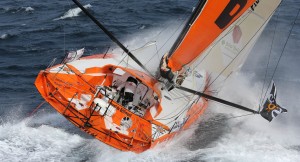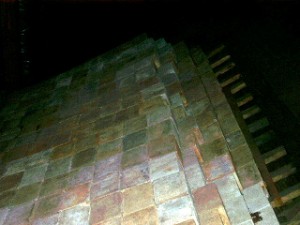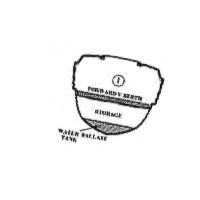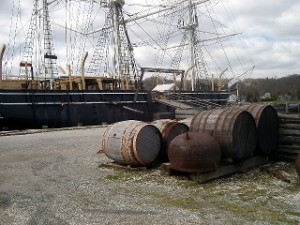James Boyd in his April 2005 Sailing World article (page 45) notes that the Vende Globe machines with canting keels also have water ballast. The question as to which is the primary ballast system on boats that have both may have been answered in that article.

Vincent Riou, who is kind of a McGyver (technically proficient) when it comes to fixing things, was unable to fix hydraulic rams used to cant PRB’s keel. This forced him to drop the keel down to leeward before any maneuver in the Southern Ocean passage of the 2004/2005 Vende Globe race, slowing things down considerably. However Boyd paints the failure of one of six centerline water ballast tanks on the same boat as more dramatic. The tank could not be repaired allowing air to enter it in a way that meant that 1.5 tons of water ballast could not be used effectively when PRB was on port tack. Boyd says there was an “explosion” involving the tank. So both ballast systems had failures. We come to see from Boyd’s article that water ballast is the primary movable ballast form 50 miles from the finish line when the newly-launched-for-the-race Ecover’s canting keel falls off.
 Rather than abandoning the race. Golding, fills the water tanks, extends the twin outboard dagger boards and twin rudders and then further stabilizes the boat by reducing sail. In this “big dinghy” configuration, Ecover sails at 9 knot speeds to become the first monohull in recent history to ever have finished a major race without the benefit of an external keel foil. The experience of PRB and Encover should be conclusive regarding which form of movable ballast is best.
Rather than abandoning the race. Golding, fills the water tanks, extends the twin outboard dagger boards and twin rudders and then further stabilizes the boat by reducing sail. In this “big dinghy” configuration, Ecover sails at 9 knot speeds to become the first monohull in recent history to ever have finished a major race without the benefit of an external keel foil. The experience of PRB and Encover should be conclusive regarding which form of movable ballast is best.
2004-2005
300,000 people watched the start of the 2004 race, which for once took place in mild weather. A fast start was followed by a few minor equipment problems; still, the first racers crossed the equator after just 10 days, three days faster than the previous race, and all of the starters were still sailing.
Attrition began on entry into the roaring forties: Alex Thomson diverted to Cape Town to make unassisted repairs and continue racing, and a number of other problems hit the fleet.Hervé Laurent retired with serious rudder problems, Thomson abandoned, and Conrad Humphreys anchored to make unassisted rudder repairs. Gear problems and abandonments continued; then the fleet ran into an area of ice, with Sébastien Josse hitting a berg head-on.
As the fleet re-entered the Atlantic, the lead changed several times; the race remained close right to the finish, which saw three boats finish within 29 hours.
| Sailor | Yacht | Time |
|---|---|---|
| PRB | 87d 10h 47′ 55″ | |
| Bonduelle | 87d 17h 20′ 8″ | |
| Ecover | 88d 15h 15 ’13” | |
| Temenos | 92d 17h 13′ 20″ | |
| VMI | 93 d0h 2′ 10″ | |
| Virbac-Paprec | 98 d3h 49′ 38″ | |
| Hellomoto | 104d 14h 32′ 24″ | |
| Arcelor Dunkerque | 104d 23h 2′ 45″ | |
| Ocean Planet | 109d 19h 58′ 57″ | |
| Max Havelaar / Best Western | 116d 1h 6′ 54″ | |
| ROXY | 119d 5h 28′ 40″ | |
| AKENA Vérandas | 125d 4h 7′ 14″ | |
| Benefic | 126d 8h 2′ 20″ | |
| Did not finish | ||
| Pro-Form | technical problems | |
| Sill Véolia | keel problems | |
| Hugo Boss | hole in the deck | |
| VM Matériaux | broken boom | |
| Skandia | lost the keel | |
| UUDS | rudder problem | |
| Brother | keel problems | |
The above race results appear to prove that water ballast is superior to external fin ballast. However debate continued because of vested interests in canting technology and bulb keels, which I view as a second hull. The best countering argument to water ballast being the deciding factor in the race involves the fact that PRB had the benefit of high speed Internet access where as the other sailors were not able to keep their computer and wireless equipment operating at that speed. Fast web surfing for weather and sea information, in combination with a center foil that could gybe to windward meant Riou could find better wind and sea conditions, point high to get to them, and make a better course to the finish line to win. This argument ignores the fact that Riou had moved ballast off of the canting keel of PRB by using a significantly smaller bulb and thinner foil so that he could add an additional internal (though possibly flawed) water ballast tank.
 Pascal Conq and Guillaume Verder further explained PRBs tanks in an article in the July 2005 Seahorse magazine (page 45). PRB has water ballast tanks remarkably similar to Mac26x vessels. The designers call these tanks inertia ballast tanks and they are placed to make the center of gravity align with the center of buoyancy at a 10 degree angle of heel. Additional tanks along the centerline running bow to stern were being contemplated. These are now allowed. The inertia ballast tanks provide substantial extra righting moment. “The distribution of these low centre of gravity ballast tanks is chosen to offer both increased inertia to go through waves in the upwind condition and to counteract the pitching moment induced by the sail driving force in the reaching condition. This set-up was first trialled on Christophe Auguin’s successful Finot 60 Geodis some 10 years ago.” Christophe Auguin sailed Geodis to victory in both the 1994-95 Around Alone and 1996-97 Vendee Globe. PRB continues to demonstrate the winning ways of this design.
Pascal Conq and Guillaume Verder further explained PRBs tanks in an article in the July 2005 Seahorse magazine (page 45). PRB has water ballast tanks remarkably similar to Mac26x vessels. The designers call these tanks inertia ballast tanks and they are placed to make the center of gravity align with the center of buoyancy at a 10 degree angle of heel. Additional tanks along the centerline running bow to stern were being contemplated. These are now allowed. The inertia ballast tanks provide substantial extra righting moment. “The distribution of these low centre of gravity ballast tanks is chosen to offer both increased inertia to go through waves in the upwind condition and to counteract the pitching moment induced by the sail driving force in the reaching condition. This set-up was first trialled on Christophe Auguin’s successful Finot 60 Geodis some 10 years ago.” Christophe Auguin sailed Geodis to victory in both the 1994-95 Around Alone and 1996-97 Vendee Globe. PRB continues to demonstrate the winning ways of this design.
 Yacht World reports that Sailing ships as early as the 17th century used to hold water (in barrels) or boulders or bricks or cargo, all secured in place, in the lower part of their hulls. When the ships heeled, these items provided a natural righting moment. Something that we need to get our heads around is that any water under the waterline does not in itself provide righting moment, however, as soon as the water moves to above the waterline (as the vessel heels, it works as ballast. The other aspect to consider is that the wider the vessel, the more heeling moment is offered by the water ballast – the old image of weight on the end of a see saw may paint a clearer picture. Of course, if one can move the water from one side to the other (typically the windward side) then the water ballast system becomes even more efficient. To this should be added the concept of live ballast. Rail Meat is a form of water ballast.
Yacht World reports that Sailing ships as early as the 17th century used to hold water (in barrels) or boulders or bricks or cargo, all secured in place, in the lower part of their hulls. When the ships heeled, these items provided a natural righting moment. Something that we need to get our heads around is that any water under the waterline does not in itself provide righting moment, however, as soon as the water moves to above the waterline (as the vessel heels, it works as ballast. The other aspect to consider is that the wider the vessel, the more heeling moment is offered by the water ballast – the old image of weight on the end of a see saw may paint a clearer picture. Of course, if one can move the water from one side to the other (typically the windward side) then the water ballast system becomes even more efficient. To this should be added the concept of live ballast. Rail Meat is a form of water ballast.
Wooden Boats
 After many comments from those helping me understanding this ballast business, I was pointed to WoodenBoats November/December 2000 issue which has been the most helpful article I have come across. I keep that now with my owners guide, and thank the wooden boat building enthusiasts for advancing the use of water ballast. To quantify things, water ballasted designs, where the ballast is located as far outboard as possible, are roughly four times more stable at 10 degrees of heel, three times more stable at 30 degrees, and twice as stable at 50 degrees than similar vessels with weighted centerline keels. (see G$ 24) The off centerline as far as possible arrangement lowers the center of gravity and “maximizes stability at low heel angles, since the flotation effect of the windward keel is quickly lost if the boat heels enough to pull it from the water. This is exactly like a catamaran.” The bottom line is that the Mac26x design has much more stability than traditional mono hulled boats and less capsize risk than multi hulls.
After many comments from those helping me understanding this ballast business, I was pointed to WoodenBoats November/December 2000 issue which has been the most helpful article I have come across. I keep that now with my owners guide, and thank the wooden boat building enthusiasts for advancing the use of water ballast. To quantify things, water ballasted designs, where the ballast is located as far outboard as possible, are roughly four times more stable at 10 degrees of heel, three times more stable at 30 degrees, and twice as stable at 50 degrees than similar vessels with weighted centerline keels. (see G$ 24) The off centerline as far as possible arrangement lowers the center of gravity and “maximizes stability at low heel angles, since the flotation effect of the windward keel is quickly lost if the boat heels enough to pull it from the water. This is exactly like a catamaran.” The bottom line is that the Mac26x design has much more stability than traditional mono hulled boats and less capsize risk than multi hulls.



The primary form of ballast in a modern racing sailboat is water ballast. Many new high-performance racing and cruising sailboats are being manufactured with built-in rigid internal water ballast tanks to improve their upwind performance. Water ballast tanks can be filled as needed to provide righting moment when required for racing. Live ballast, or the weight of the crew, is the simplest form of ballast used in small day sailers.
The disadvantages of using water ballast in sailboats include the fact that water is not very dense, and therefore the tanks required take up more space than other forms of ballast. Water ballast is also slower to move around the boat than a typical crew, and filling a tank typically takes on the order of 5 minutes. However, water ballast offers relative simplicity and has the advantage that the boat is operating at a significantly lighter weight when unballasted, which can improve speed and efficiency under power. Additionally, water ballast can provide righting moment when required for stability requirements for offshore racing.
See Perplexity App
2012 PRB lightest in fleet
http://sunshineandsails.com/best-sailing-races/